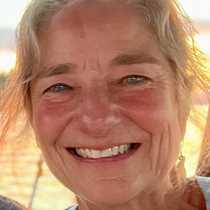Special Note: This week, we are pleased to welcome Ben Lyons, Chief Officer of the National Geographic Explorer, to the NG Sea Bird in Southeast Alaska. We invite you to follow Lyons in Alaska, a special section of the Lindblad Expeditions Blog.
Thomas Bay & Petersburg
We awoke to glassy calm waters and clear skies in Thomas Bay. In the distance was Baird Glacier, which has now retreated so it no longer reaches salt water. The National Geographic Sea Bird quietly cruised into one corner of the bay called ‘Scenery Cove,’ a narrow inlet whose rock edges were polished by a glacier long ago. Just before breakfast, the ship quietly nosed in towards a rocky beach, and we silently watched a black bear forage for barnacles at low tide.
We spent the rest of our morning at Cascade Creek, where many of us explored the lush, mossy forest. Ferns were emerging from the ground, just beginning to unfurl. As we watched water rush down Cascade Creek’s boulders and waterfall, two American dippers flew to their perches next to the powerful, rushing water. In the distance we heard songs of the winter wren and varied thrush. Spring is here and birds are singing!
After lunch we arrived at Petersburg, an important Southeast Alaskan fishing port. We tied up near well-outfitted fishing boats, a stone’s throw from the town’s Sons of Norway Hall. Later this week the town will have celebrations for Norwegian Independence Day. Petersburg’s Norwegian heritage is celebrated by the flags, street names, traditional rasmaling painting, and fishing. We spent our time here strolling through town, walking along docks lined with fishing boats, and exploring forest and bog (muskeg). Many of us enjoyed flightseeing high over Le Conte Glacier.
Our recap featured two special friends of Lindblad: first, Becky Knight talked about the town’s very successful fishing industry. Then Fred Sharpe, a humpback whale researcher, discussed his studies of Southeast’s humpbacks. We feasted on local Dungeness crab and ribs, and after dinner’s end, we watched a colorful sunset in Frederick Sound.
Thomas Bay & Petersburg
We awoke to glassy calm waters and clear skies in Thomas Bay. In the distance was Baird Glacier, which has now retreated so it no longer reaches salt water. The National Geographic Sea Bird quietly cruised into one corner of the bay called ‘Scenery Cove,’ a narrow inlet whose rock edges were polished by a glacier long ago. Just before breakfast, the ship quietly nosed in towards a rocky beach, and we silently watched a black bear forage for barnacles at low tide.
We spent the rest of our morning at Cascade Creek, where many of us explored the lush, mossy forest. Ferns were emerging from the ground, just beginning to unfurl. As we watched water rush down Cascade Creek’s boulders and waterfall, two American dippers flew to their perches next to the powerful, rushing water. In the distance we heard songs of the winter wren and varied thrush. Spring is here and birds are singing!
After lunch we arrived at Petersburg, an important Southeast Alaskan fishing port. We tied up near well-outfitted fishing boats, a stone’s throw from the town’s Sons of Norway Hall. Later this week the town will have celebrations for Norwegian Independence Day. Petersburg’s Norwegian heritage is celebrated by the flags, street names, traditional rasmaling painting, and fishing. We spent our time here strolling through town, walking along docks lined with fishing boats, and exploring forest and bog (muskeg). Many of us enjoyed flightseeing high over Le Conte Glacier.
Our recap featured two special friends of Lindblad: first, Becky Knight talked about the town’s very successful fishing industry. Then Fred Sharpe, a humpback whale researcher, discussed his studies of Southeast’s humpbacks. We feasted on local Dungeness crab and ribs, and after dinner’s end, we watched a colorful sunset in Frederick Sound.




